Roger Clarke's Web-Site
© Xamax Consultancy Pty Ltd, 1995-2024

Infrastructure
& Privacy
Matilda
Roger Clarke's Web-Site© Xamax Consultancy Pty Ltd, 1995-2024 |

|
|||||
| HOME | eBusiness |
Information Infrastructure |
Dataveillance & Privacy |
Identity Matters | Other Topics | |
| What's New |
Waltzing Matilda | Advanced Site-Search | ||||
Proc. 4th Int'l Wksp on Requirements Engineering for Sustainable Systems (RE4SuSy), Ottawa, 24-28 Aug 2015
PrePrint of 15 July 2015
Rani Yesudas and Roger Clarke **
© Rani Yesudas and Xamax Consultancy Pty Ltd, 2015
Available under an AEShareNet ![]() licence or a Creative
Commons
licence or a Creative
Commons  licence.
licence.
This document is at http://www.rogerclarke.com/EC/SM-PA.html
Understanding the stakeholder's needs, particularly the end-user's need is important when designing and developing a critical infrastructure like power grid. Smart metering systems are considered as a vital element in grid modernisation projects. It provides the utility with a range of opportunities to improve their business. The benefits to other market parties are also clear. But the residential consumers are left behind. Many smart meter- ing projects, across the world, are facing consumers' resistance. Consumers perceive smart meters as an infringement to their interests and rights. To avoid such situations, objectives of smart metering systems should also reflect consumer needs. Measures need to be devised to elicit and include their requirements. To address this issue we analyse the reported concerns from the consumer and thereby identifying requirements for different consumer segments. That enables us to propose functionalities and applications that will help the user utilise energy efficiently.
Electricity providers are facing challenge in implementing new technologies to modernise the grid. Though the components of the grid vary from region to region, the key elements are the same. Smart meter (SM) and the Advanced Metering Infrastructure (AMI) are considered as vital elements that can play an important role in managing peak demand [1].
The energy industry is currently facing challenges in maintaining constant delivery of electricity to consumers. One of the main concerns with the power grid is in meeting the peak demand using the traditional infrastructure. Other issues include the smooth integration of a range of low carbon technologies such as renewable energy sources and electric vehicles. A smarter power grid is seen as a necessity for an effective system that is stable, reliable and secure [1-3]. The deployment of smart meters on consumer premises has been the utilities' starting point for grid modernisation. Such projects involve expensive infrastructure that is paid for, whether directly or indirectly, by consumers, and hence it is important to achieve consumer confidence.
There have been multiple instances of major consumer pushback against smart meters, for example in Victoria, California and Ontario [4]. This has resulted in project-sponsors battling to convince consumers of the potential benefits and this may continue for years. A technology will not be welcomed by the end user if it is not useful for them, even if it could contribute to solving major issues like lowering carbon emissions and climate change [5] .
The utilities introduced smart meters with the expectation that energy consumers would use it as a tool to reduce peak energy usage. The concerned entities expected that, with few market choices, and a smart meter, the consumer would be well equipped to manage their consumptions efficiently [6, 7]. In fact, most consumers feared that they would not be able to avoid the peak periods and that their bills would increase. They suspected that the utility's motive for the smart-meter rollout was to make a profit at the cost of the consumer [8]. Further, when the system lacked visible benefits, but showed possibilities for harm, other perceived risks like health and privacy became more prominent.
AMI's business-centric characteristics lacks functionalities useful for the end-user and this is the main motivation for the the research described in this paper. The problem domain in AMI, related to the residential consumer, is relatively new in energy industry. In the traditional grid, consumers were passive users and they just had to pay for their usage. In the modern grid, consumers are expected to become active members by managing their power usage. All the concerns from electricity consumers imply that the implemented system is either not useful for them or they have been ignored during requirement analysis. There is a possibility that the consumer requirements were merely assumed by the analysts. Creating a successful system also requires translating the end-users needs into the product scope. Late corrections of requirements errors are expensive and hence it is necessary to analyse and refine requirements before implementing a system.
Through this research we intend to understand consumer concerns and identify measures that could be applied to AMI projects to make them beneficial to the consumers as well. We have used Design Science [9, 10] as the research method for creating artifacts that embody such remedies. Buckminster Fuller's vision [11] is applied to analyse the problems that the smart metering projects pose to the consumer.
Through this paper we try to identify consumer-focused solutions using smart metering system. The remainder of this paper is structured as follows. In Section II we provide a background on smart metering systems and in Section III we provide a literature review on residential consumer and their energy choices. In section IV we identify problems underlying the consumer concern. In section V we conduct a detailed problem analysis. In section VI we list the alternative measures based on existing technology. In sections VII and VIII we discuss the proposed measures and evaluate it. Finally in Section IX, we conclude our work discussing future directions.
The main elements of the Smart Metering System/Advanced Metering Infrastructure (AMI) are, the smart meter, the head-end data storage within the utility and a network to support the two-way communication. The smart meter is designed to record detailed energy usage on the consumer premises. This detailed data is transmitted to the utility to enable billing and Demand Response (DR) operation.
Federal Energy Regulatory Commission (FERC) defines DR as "the change in electric use by consumer from their normal consumption patterns in response to changes in the price of electricity and it also refers to the incentive payments designed to induce lower electricity use at times of high wholesale market prices or when system reliability is jeopardised". Direct Load Control (DLC) and Time-of-Use (TOU) pricing are the two main programs under DR. DLC is defined as a "mechanism by which the program sponsor remotely shuts down or cycles a customer's electrical on short notice". TOU is defined as "a rate where usage unit prices vary by time period, and where the time periods are typically longer than one hour within a 24-hour day. Time-of-use rates reflect the average cost of generating and delivering power during those time periods" [12].
With TOU and DLC, utility can control customer's energy usage. Utility providers expected that the consumer will use the TOU information to reduce electricity consumption during the peak period. Two ways in which the declaration is provided to the consumer are by means of an In-House-Display (IHD) integrated with the smart meter, and a web-based `energy portal'. However, they are optional.
Consumers have issues in accepting smart meter and its functionality. Opposition by residential consumers have become a big decision factor in some smart meter roll-outs [13, 14]. Even a minority segment of consumers can become the reason for abandonment of a project after research and development have been done and a great deal of funding has been committed. It is essential to understand consumer reaction to smart meters.
In this section we analyse research studies that have been conducted on energy consumers, their demand choices and factor affecting acceptance of smart meter. The articles that we have considered are listed below.
Kranz et al. investigated smart meters' acceptance factors in Germany. An online survey on the project website attracted 351 participants in the age range 18 to 78. Perceived usefulness followed by subjective control were the main factors that affected a person's attitude to use a smart meter. Perceived ease of use affected perceived usefulness. [15]
Stragier et al. investigated consumers' perception of smart meter and smart appliances in Flanders, Belgium. A large-scale face-to-face user survey sought insight into the willingness of consumers to adopt smart meters. Factors included housing parameters, mobility, insulation measures, heating, lighting, energy patterns, domestic appliances, ICT and multimedia, ecological behaviour, ecological attitude, socio-demographic parameters like gender, age, income and impressions of smart appliances. Perceived Ease of Use and Perceived Usefulness had significant influence on attitude towards smart metering system. Perceived Ease of Use had a strong influence on Perceived Usefulness. [16]
Dunstan et al. investigated barriers of Demand Management in Australia. About 808 groups from a range of stakeholder groups participated in a survey. The statements "B22 - electricity consumer lack interest in saving energy" and"B23 - consumers want to use power when and how they choose" were not thought by participants to be true. They thought that consumers are interested in saving energy and that consumers' reluctance to accept smart meters was because of a lack of useful functionality [17].
Firth et al. identified the influence of appliances usage and energy user groups on demand in UK residential consumers. 72 dwellings at five sites were monitored over a period of 2 years. Consumers were segmented into low, medium and high usage. Appliances were classified as active, stand-by and cold use. Consumption increased more than 4% from the first to the second year, with standby appliances being the major contributor, followed by active appliances. Low and high users increased consumption more than medium-usage consumers [18].
McLoughlin et al. identified consumption characteristics based on dwelling and occupant characteristics in Irish dwellings. This study of 4200 consumers looked at the influence of appliances and of income on energy consumption. The largest contributors to demand were tumble dryers, dishwashers, electric cookers and electric heaters as they all had large heating components. The high energy consumers were mostly high income professionals [19].
Based on above consumer studies and several similar studies, the following can be concluded.
In this section we are analysing the consumer concerns which will help in identifying solution. Information regarding system risks and consumer concerns were acquired, using publications by entities related to the power industry, and where necessary from media sources. Based on the nature of the consumer concerns, we classify them as follows:
There have been complaints that smart meters cause health problems. Complainants use the term Electromagnetic hyper-sensitivity (EHS) to refer to a range of health issues that they link to transmitting devices. The existence of EHS is contested, and some of the literature refers instead to Idiopathic (i.e. `cause-unknown') environmental intolerance (IEI) [20] . Smart meters have a communication module for transferring data to the remote server, which may transmit and may receive using electromagnetic radiation. The meter manufacturers respond that they have complied with industry standards, and that radiation from smart meters is much lower than that from mobile phones [21, 22].
The detailed data from smart meters are capable of revealing people's lifestyle, occupancy and contents in a dwelling [23]. Smart meter data is susceptible to modification and destruction during transfer. There are also fears that blackouts and other disasters could be caused by malicious hackers [24]. Utilities respond that the meters have a firewall and basic encryption and there have been no cases of reported attacks.
The new infrastructure incurs huge cost. Some costs may be borne directly by consumers, but in any case they fear that they will bear the cost of developing, running and maintaining the system. It is also not clear if smart metering system can reduce bills as claimed by utilities. Consumers have reported increased electricity bills associated with the use of smart meters
It has been reported that power surges have caused some smart meters to overheat and start a fire. Poor quality components and improper assembly of meters has been noted as the reason for overheating [22, 25].
By itself, a smart meter does not enable a consumer to manage their energy needs. They need both notification of peak-periods and the ability to turn particular appliances off or down. The possibility exists for home automation, if all appliances could be operated via the smart meter, possibly remotely as well as locally [26]. But these are aspirations rather than currently-delivered capabilities, and in any case it is not practical for most residences, because people generally replace their appliances only at the end of their normal life.
There are also concerns about some consumers being unable to avoid peak demand, resulting in huge electricity bills. Utilities expect consumers to utilise smart meter facilities, and adjust their consumption behaviour accordingly. On the other hand, consumers who stay at home most of the time can't avoid peak as they will have to operate at least some and perhaps most of their appliances. People with low financial capacity may not be able to invest in solar panels and other alternatives [26]. It is also difficult for most consumers to understand the demand signals, decide on a course of action, and make the necessary changes. Consumers are also hesitant to give control over their appliances to the utility. Consumers want to choose how they operate their appliances.
Doubts exist about the basis of health concerns, and fire risk is a straightforward issue of product safety. This section considers the other concerns identified above, all of which are related to the functionality of the smart metering system.
Consumer resistance has often been associated with circumstances in which the demand response (DR) functionality has been designed without taking into account important factors that affects consumer's energy choices. Existing research [15-19, 27] suggests that following characteristics have been found to affect demand choices:
The above analysis makes it evident all residential consumers cannot be assumed to be homogeneous. They do not all respond to the demand response signal in the same way. In this section we analyze how different consumer segments will respond to the TOU signal on a winter day and the issues they will face. Figure 1 shows the TOU Tariff issued by two power companies in Canada. [28, 29]
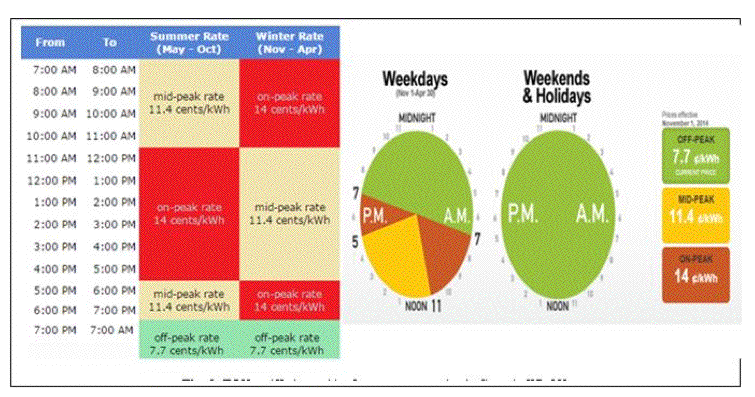
The higher rate is from 7 am to 7 pm, with peak-rates 7 am - 11 am and 5 pm - 7 pm. The analysis assumes that electricity is used for all purposes, which are primarily heating, cooking and cleaning. Then we identify several segments, referred to below as the common case and specific cases.
(1) The Common case
Most residential consumers are active between 7 am and 10 pm. So they have some unavoidable energy needs during that period of the day. In general, heating will be required from 5pm - 7 am in most cases and even more in others.
(2) Specific Cases
A single working professional is out of their dwelling during work hours. They can also avoid cooking by eating out. They can also choose to be away from home during the peak demand periods. Their usage can then be limited to night/resting time.
Working parents with school-going children can avoid consumption during work-hours, but after and before work-hours they have unavoidable energy requirements for cooking, cleaning, etc. It is not easy to avoid those activities or the peak period 6 am - 9am and 4 pm - 7pm].
Stay-at-home parents with young children can organize some high energy consumption activities during off-peak time, e.g cooking and washing, but they cannot avoid heating the dwelling, and if it is not energy efficient their heating requirements will be higher. They can possibly go out during the day to reduce energy usage, but it is not easy to make it a daily activity.
Pensioners and people with medical needs face a situation very similar to Stay-at-home parents, but as they may have mobility issues and medical conditions that prevent them from leaving out, they will have energy needs throughout the day. Moreover they may also have life-supporting machines that will draw even more electricity.
Work-from-home professionals work and live in the same premises, and hence have energy needs throughout the day. Their energy needs will be high throughout their work-hours.
From the above analysis it is evident that very few consumer-segments can adapt their energy needs to reflect the TOU pricing periods. In effect, TOU tariffs penalise many consumer segments for factors that are outside their control. It is clear that important end-user realities and needs have not been taken into account during the requirement engineering process that has been applied to the smart metering projects.
Apart from accurate billing, the utilities' main business goal in introducing smart metering system is to facilitate demand curtailment. Alternative measures could be considered which may incur lower implementation cost and risks. Three such alternatives are discussed below:
Electricity substations have control mechanisms by which load can be selectively shed at feeder level [30]. If the demand is much more than generation capacity, this mechanism can be used to shed load in that area for short intervals. This demand curtailment method is easier, as it does not have too many extra parameters to consider. The provider only needs to choose the feeder and time-period for which the load has to be shed. This mechanism is already in use and usually the time and details of when the load will be shed will be declared in advance so that the end-users can take necessary measures to overcome the power loss. It can, however, have serious consequences for some consumer segments, such as people with medical needs and home-working professionals.
Another mechanism that is used for demand management is higher tariffs for excess usage. There is an allotted quantum of energy for each household in a given period. Usage above the allotted amount incurs a higher tariff. This way demand is not curtailed, but the higher production costs can be transferred to the user.
Prepayment meters are in use in few countries. Payment has to be made in advance, and the consumer can only use for what has been paid for. In countries where a consumer cannot be disconnected by law, the end-user continues to get minimum amount of energy until the next payment is made. This method could be used for limiting excessive usage. Every household could be allotted a set amount of energy, beyond which they cannot purchase, thereby restricting demand.
As it is observed that there are cheaper mechanisms to induce demand reduction, the introduction of smart metering systems requires justification. User requirements analysis needs to take into account not just the providers' needs but also those of consumers. In this section using the artifacts identified by analysing the problem; we are proposing consumer classification that will cover a wide variety of consumer and then identify requirements that suit those segments. Consumer segmentation is based on users' capability to utilise the demand signals issued by the utility. The proposed classification is shown in Table 1.
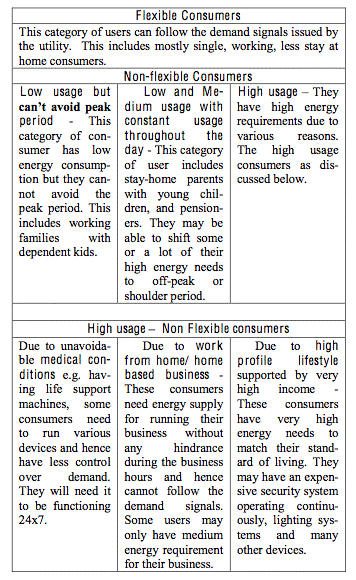
Based on the analysis done in the previous section, we prose an informative feedback and varied billing for each consumer types. Consumers need a system that will provide them with informative feedback on their usage patterns and provide them with hints to make intelligent choices and avoid energy wastage. The customised billing options will provide user with opportunity to make changes/ reduction in their usage pattern within their limitation. Tables 2 and 3 provide user requirements for feedback and billing.
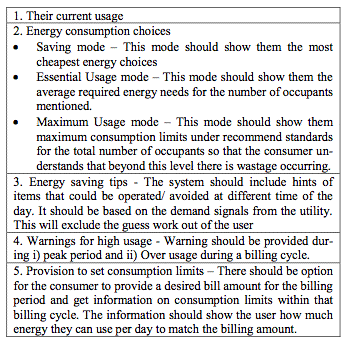
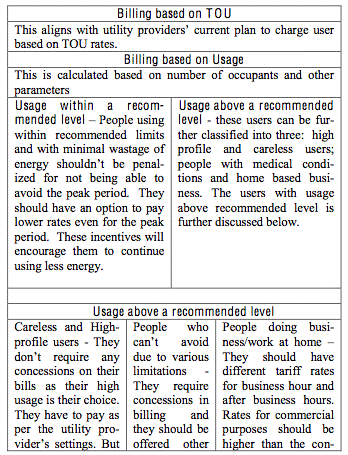
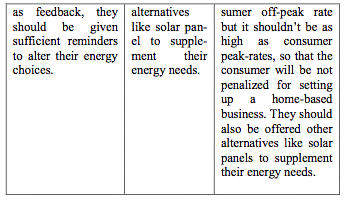
On the basis of the analysis conducted above, it is now feasible to propose modifications to existing smart metering architecture. Currently, in the smart metering system there is only an In-House-Display (IHD) and an online energy consumption displaying system for feedback. The IHD displays the consumption data recorded in the consumer's smart meter and the online system displays the energy data that is transmitted and stored at the utility's side. Both the systems also display the demand signal like peak period and tariffs rates. The need exists for an intelligent feedback mechanism rather than just display of usage data and tariffs. The current data does not make the consumers well informed about the choices they have. Hence the smart metering system needs to incorporate a Consumer Energy management System (CEMS) that uses both consumer input and signals from the utility. Additional information such as weather data may also be drawn from external entities for fine tuning the calculations. An overview of the modified system is provided in Figure 2. The recommendation on billing options can be done within the smart metering module based on the setting provided by the utility.
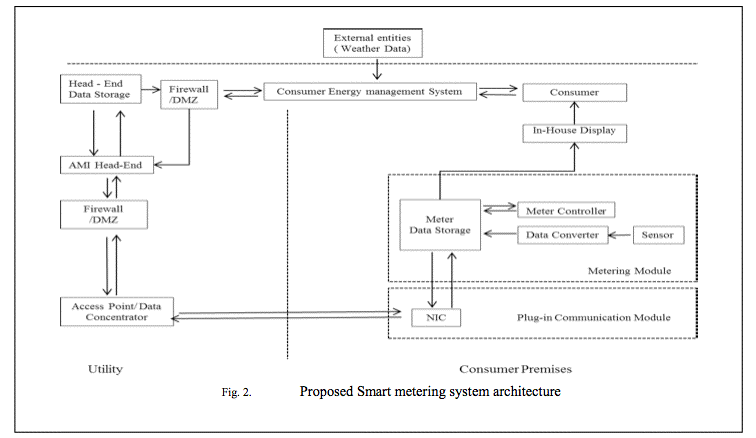
1) Accurate Usage details
This feature is currently present in many smart meters. The usage is displayed using the IHD integral to or connected with the smart meter and also in the provider's online usage display system. This usage data may also be displayable in the proposed CEMS by synchronizing it with head-end data.
2) Energy consumption and Billing related advices
These advices mainly rely on consumer input. CEMS will allow the user to input data related to dwelling characteristics, occupant characteristics and appliance characteristics. This will give sufficient information to calculate the energy requirement for the household. It can be fine-tuned with the weather data from external entities. The accuracy of the calculation will be dependent on the information provided by the user. Further, the system will have to fetch the demand signals from the utility. Based on this information, the billing and warning information can be generated. To calculate consumption information by providing a bill amount, the demand signal from the utility alone is sufficient. The user can input a desired amount and the system can calculate the consumption threshold to match the desired bill amount.
3) Billing Option for different Category
The smart meter is capable of storing accumulated usage data for each demand period (peak, off-peak and shoulder). The rates that are applied will vary according to the user type. The head-end will have to store a user profile based on the user category and it will have data regarding allotted energy for the household, the category the household belongs to, and the rates that apply for the category. For each billing cycle, this information will be applied to generate a customized bill for the user. For a home-based business, because their power-usage for commercial purposes depends on their business-hours, it is better to have their meters accumulate data based on work-time (working hours, outside working hours) rather than demand period.
1) CEMS should be able to operate both online and as a standalone program.
The proposed system should be able to operate in 3 different modes as stated in Table III.
2) User profile data stored by the utility is used only in accordance with the terms of the consumer's consent.
A user profile will be stored at head-end to choose the billing category and other related matter. The utility should ensure that the details are only used for the billing purpose and that a third party can gain access to it only with consumer consent.
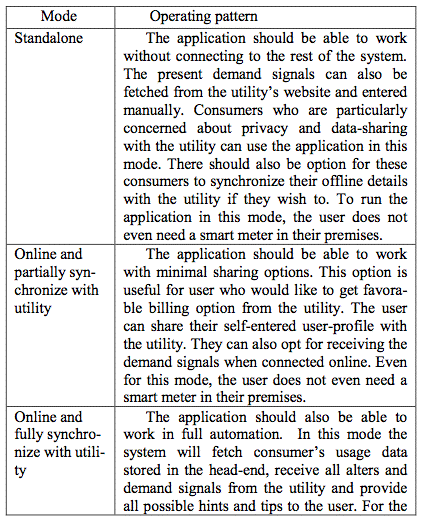

8.1 Evaluation of Design
This section discusses how the proposed features affect the current system.
1) Feasibility with the current context
The design measures that we propose primarily add end-user value to the smart metering system so that consumers can make informed choices. Current smart metering systems have an online energy management system that displays the consumer's usage, alerts from the utility and demand signals. From this information, users have to make assumptions and make decisions. With the CEMS, the information is already processed so that it can be easily used by the consumer. Even consumers who have opted out of smart meters installed in their premises can use this system because it can work as a standalone tool. Even if the user does not have access to real time consumption data, they can receive tips on how to reduce energy wastage based on the data they input to the system.
2) Effects on other Smart Metering Functionality
The proposed measures do not affect the technical specification of the smart meter. The billing categorization is a customizable feature. Smart meters have the capability to categorize usage data based on time period. The time period can be programed to the meter to classify consumption. Currently this is done based on demand period, because this setting is sufficient for most of the user categories. For home-based workers, the meter needs to be programmed to classify time period based on work-time. These are customizable settings within the smart meter that can be easily changed. These features also do not affect remote operations or communication features of the smart meter.
3) System Limitations
The two design adaptations proposed are dependent on user information. The user profile needs to be accurate as it will be used to calculate bills. Hence the utility will have to use other verification methods to make sure that such information provided by the user is truthful. They will need to verify tenancy contracts, income certificates and government approved documents on special needs and family member listings.
For the feedback system, the data accuracy is not as vital as it is for the billing system. The users should be informed that the calculations will be based on their input and hence discrepancies will be observed if they don't provide accurate information. The utility provider can educate the consumer in appropriate use of the facility.
The details entered for the feedback system could profile the user. It could provide [16] detailed information about appliances, their use, and the lifestyle of the user. These recommendations therefore do not solve the existing privacy issues that the system is facing, but neither does it aggravate it. But consumers have choice to work with the application as standalone and that way they can choose not to share their information with the utility. Needless to say, the system needs to be secure, to ensure there is no theft of user profiles and user data.
In this section we evaluate the effectiveness of the smart metering system in a particular setup. For that we choose the smart metering project in Australia. The Department of the Environment, Water, Heritage and the Arts (DEWHA) prepared the initiatives for the smart grid system in Australia and it primarily focused on distribution and retail value chain elements. Two main applications that were considered as part of the primary smart grid technologies were the customer-side application and its key enabling application.
DEWHA also insisted that trials should be made to fully test the benefits of the consumer applications. For the trail they also suggested that customer segments with different patterns of electricity use be identified and included, because each segment appeared likely to respond differently to the customer applications components being tested [31]. The Victorian Government mandated the implementation of smart meters for residential customers in 2006 and the rollout commenced in 2009. The system mostly used RF mesh technology for its communication. Energy price deregulation was also introduced for all consumers to complement the smart meter roll-out. But there was huge resistance the TOU tariff scheme from consumers and advocacy groups such that the providers had to permit consumers to remain on the old flat-rate tariff, even after the deployment of smart meters [32].
The Australian Smart meter scheme clearly shows that smart meters were rejected by the consumers as it was not clear how the consumers could benefit from the system. Our proposal considers different consumer segments and suggestions that support each group. Using our proposed scheme different user groups can be provided different billing options.
Smart metering systems have the potential to contribute to smart grids and improved energy management. These systems benefit the utility because billing is more accurate and manual reading costs and errors are avoided. The infrastructure required for the system is vast and the meters are expensive. This cost is ultimately borne by the consumer, yet in projects to date they have gained very limited benefits from smart meters.
To tackle consumer concerns the commonly provided solution is to educate and engage the consumer to use the system[33, 34]. But that does not justify the need to introduce smart metering system. The alternative measures we have suggested in section VI are sufficient to reduce demand. If consumers have to actively engage in power management, the system should provide them with useful and easy to use choices.
A limitation to the research was that, due to the nature of the project, user survey and field testing was not a feasible. Moreover we have not considered the usage of electronic vehicles (EV). EVs may draw more power. Hence it can make a huge difference in the power requirement for the concerned consumer. But we would like to suggest keeping EV power requirements separate from other residential energy requirements until they are widely used. It would be preferable to keep a separate power line for charging EVs and billed separately. We started our analysis by choosing the problem situation in smart metering system. Then preferred states were identified by extracting consumer-friendly user requirements. Based on the requirements, an abstract architecture and functional specification were proposed. It was then shown how those features could be added to the existing system. We have proposed adaptations to the artifacts that feature intelligent feedback mechanisms and more billing options to suit different consumer categories. The evaluation suggests that current smart metering systems can be readily modified to add the proposed features. But the efficiency relies on the accurate details provided by the user.
[1] Y. Yan, Y. Qian, H. Sharif, and D. Tipper, "A Survey on Smart Grid Communication Infrastructures: Motivations, Requirements and Challenges," Ieee Communications Surveys and Tutorials, vol. 15, pp. 5-20, 2013.
[2] H. Farhangi, "The Path of the Smart Grid," Ieee Power & Energy Magazine, vol. 8, pp. 18-28, Jan- Feb 2010.
[3] S. M. Amin and B. F. Wollenberg, "Toward a smart grid: power delivery for the 21st century," Power and Energy Magazine, IEEE, vol. 3, pp. 34-41, 2005.
[4] UKERC, "Future Research Requirements for Smart Metering Workshop," The UK Energy Research Centre2011.
[5] R. Yesudas and R. Clarke, "Architecture and Data Flow Model for Consumer-Oriented Smart Meter Design," in Information Systems Development: Transforming Organisations and Society through Information Systems (ISD2014 Proceedings), Vara_din, Croatia, 2014.
[6] T. J. Lui, W. Stirling, and H. O. Marcy, "Get smart," Power and Energy Magazine, IEEE, vol. 8, pp. 66- 78, 2010.
[7] M. Spindleruv, "How Smart metering pilot project lost illusions and ideas or nothing is just Black and White!," Enel2012.
[8] G. Zachary, "Saving smart meters from a backlash," Spectrum, IEEE, vol. 48, pp. 8-8, 2011.
[9] S. T. March and G. F. Smith, "Design and natural science research on information technology," Decision support systems, vol. 15, pp. 251-266, 1995.
[10] A. R. Hevner , S. T. March, J. Park, and S. Ram, "Design science in information systems research," MIS quarterly, vol. 28, pp. 75-105, 2004.
[11] H. Brown, R. Cook, and M. Gabel, Environmental Design Science Primer: Advocate Press, 1978.
[12] FERC, "Assessment of demand response and advanced metering," 2008.
[13] T. Bayar. (2013, Will Germany Reject Smart Meters? Available: http://www.renewableenergyworld.com/rea/news/arti cle/2013/09/will-germany-reject-smart-meters [Accessed on 1March 2015]
[14] A. Colley (2014, Half of users abandon smart meter trial - Australia. Available: http://www.itnews.com.au/News/370919,half-of- users-abandon-smart-meter-trial.aspx [Accessed on 1 March 2015]
[15] J. Kranz, J. V. Gallenkamp, and A. Picot, "Exploring the Role of Control-Smart Meter Acceptance of Residential Consumers," in AMCIS, 2010, p. 315.
[16] J. Stragier, L. Hauttekeete, and L. De Marez, "Introducing Smart grids in residential contexts: Consumers' perception of Smart household appliances," presented at the Innovative Technologies for an Efficient and Reliable Electricity Supply (CITRES), 2010.
[17] C. Dunstan, N. Ghiotto, and K. Ross, "Barrier to demand management : report#2 of the Australian Alliance to Save energy " Alliance to Save Energy, Tech. Rep, 2011.
[18] S. Firth, K. Lomas, A. Wright, and R. Wall, "Identifying trends in the use of domestic appliances from household electricity consumption measurements," Energy and Buildings, vol. 40, pp. 926-936, 2008.
[19] F. McLoughlin, A. Duffy, and M. Conlon, "Characterising domestic electricity consumption patterns by dwelling and occupant socio-economic variables: An Irish case study," Energy and Buildings, vol. 48, pp. 240-248, May 2012.
[20] C. Baliatsas, I. Van Kamp, E. Lebret, and G. J. Rubin, "Idiopathic environmental intolerance attributed to electromagnetic fields (IEI-EMF): a systematic review of identifying criteria," BMC Public Health, vol. 12, p. 643, 2012.
[21] T. Krishnamurti, D. Schwartz, A. Davis, B. Fischhoff, W. B. de Bruin, L. Lave, et al., "Preparing for smart grid technologies: A behavioral decision research approach to understanding consumer expectations about smart meters," Energy Policy, vol. 41, pp. 790-797, Feb 2012.
[22] J. Betz (2010, Smart Meters Under Fire as Electric Bills Soar. Convention for the Protection of Human Rights and Fundamental Freedoms as amended by Protocol No. 11.
[23] E. L. Quinn, "Privacy and the new energy infrastructure," Available at SSRN 1370731, 2009.
[24] T. Baumeister, "Adapting PKI for the Smart Grid," 2011 Ieee International Conference on Smart Grid Communications (Smartgridcomm), 2011.
[25] EMFSN, "Smart Meter Fires and Explosions," 2012.
[26] R. Yesudas and R. Clarke, "Identifying consumer requirements as an antidote to resistance to smart meters," in Innovative Smart Grid Technologies Conference Europe (ISGT-Europe), 2014 IEEE PES, 2014, pp. 1-6.
[27] S. Darby, "Smart metering: what potential for householder engagement?," Building Research & Information, vol. 38, pp. 442-457, 2010.
[28] OH. (2015). Time-of-Use Pricing. Available: http://www.ontario-hydro.com/index.php page=current_rates [Accessed on 1 March 2015]
[29] OEB. (2015). Time-of-use (TOU) Prices. Available: http://www.ontarioenergyboard.ca/OEB/Consumers/ Electricity/Electricity+Prices [Accessed on 1 March 2015]
[30] S. Sridhar, A. Hahn, and M. Govindarasu, "Cyber- physical system security for the electric power grid," Proceedings of the IEEE, vol. 100, pp. 210-224, 2012.
[31] DEWHA, "Smart Grid, Smart City: A new direction for a new energy era " Department of the Environment, Water, Heritage and the Arts2009.
[32] J. Benvenuti, "Lessons from Victoria: Has deregulation delivered?," Consumer Utilities Advocacy Centre ( CUAC), Brisbane2013.
[33] Y. Strengers, "Smart metering demand management programs: challenging the comfort and cleanliness habitus of households," in Proceedings of the 20th Australasian Conference on Computer-Human Interaction: Designing for Habitus and Habitat, 2008, pp. 9-16.
[34] N. Boughen, Z. Castro, and P. Ashworth, "Understanding the residential customer perspective to emerging electricity technologies: Informing the CSIRO Future Grid Forum," Brisbane, Queensland: CSIRO, 2013.
Rani Yesudas is a software engineer with experience in the smart meters industry, and a PhD student in the Research School of Computer Science at the Australian National University.
Roger Clarke is Principal of Xamax Consultancy Pty Ltd, Canberra. He is also a Visiting Professor in the Cyberspace Law & Policy Centre at the University of N.S.W., and a Visiting Professor in the Research School of Computer Science at the Australian National University.
| Personalia |
Photographs Presentations Videos |
Access Statistics |
 |
The content and infrastructure for these community service pages are provided by Roger Clarke through his consultancy company, Xamax. From the site's beginnings in August 1994 until February 2009, the infrastructure was provided by the Australian National University. During that time, the site accumulated close to 30 million hits. It passed 65 million in early 2021. Sponsored by the Gallery, Bunhybee Grasslands, the extended Clarke Family, Knights of the Spatchcock and their drummer |
Xamax Consultancy Pty Ltd ACN: 002 360 456 78 Sidaway St, Chapman ACT 2611 AUSTRALIA Tel: +61 2 6288 6916 |
Created: 15 July 2015 - Last Amended: 15 July 2015 by Roger Clarke - Site Last Verified: 15 February 2009
This document is at www.rogerclarke.com/EC/SM-PA.html
Mail to Webmaster - © Xamax Consultancy Pty Ltd, 1995-2022 - Privacy Policy